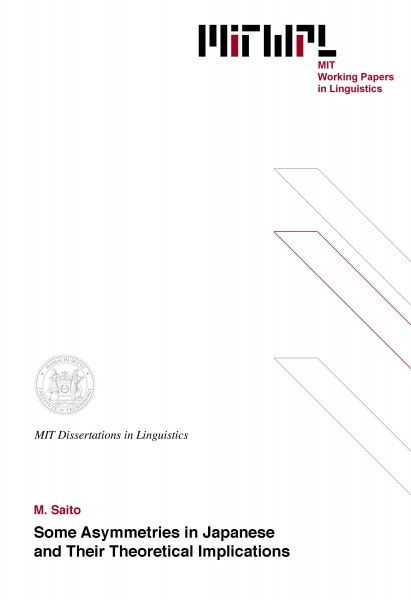Some Asymmetries in Japanese and Their Theoretical Implications
M. Saito, 1985
This thesis argues for scrambling in Japanese as an instance of S-structure Move-alpha, and examines its properties. More specifically, I argue that scrambling is an S-structure adjunction operation. It is shown that given this hypothesis, the properties of scrambling can for the most part be deduced from the interactions of the basic language-particular properties of Japanese and the principles of Universal Grammar. Thus, the discussion in this thesis supports not only this hypothesis on scrambling but also the general principles that are crucially assumed to derive the properties of scrambling.
Chapter 2 presents evidence for the configurational analysis of Japanese, and hence for an analysis of the "free word-order" facts in this language in terms of scrambling. In addition to those facts that clearly support the configurational analysis, I discuss some phenomena that seem problematic to this analysis and argue that they are expected under the hypothesis that scrambling is an S-structure adjunction operation.
Chapter 3 examines further properties of scrambling. I first argue that the relative restrictedness of "long-distance" scrambling should be accounted for on independent grounds, and hence, contrary to the recent proposals in the literature, there are no reasons to treat it separately from clause-internal scrambling. Secondly, I show that the non-scramblability of subject NPs follows straightforwardly from the nature of nominative Case markking in Japanese. Finally, I speculate on the proper characterization of scrambling itself. It is suggested that any node is a possible adjunction site for scrambling, and that successive-cyclic scrambling is possible.
Chapter 4 discusses the implications of our findings on scrambling for some traditional problems in Japanese grammar. The first problem has to do with the fact that scrambling, but not topicalization, is subject to Subjacency in Japanese. It is shown that this contrast between scrambling and topicalization is expected, given that Japanese is a PRO-drop language and that scrambling is a regular adjunction operation. The second problem has to do with the derivation of the topic construction in Japanese. I argue that contrary to the common belief, the topic construction can be derived by movement, and further, that the movement operation involved here is a subcase of scrambling.
Thesis supervisor: Noam Chomsky
Title: Institute Professor
Table of Contents
Chapter 1 Introduction 10
Chapter 2 On the Problem of Configurationality 20
2.1 The non-configurationality hypothesis for Japanese 23
2.1.1 Free word-order and the lack of VP 23
2.1.2 Dual syntactic representations 29
2.2 Arguments for a scrambling rule 34
2.2.1 Scrambling as an instance of move-alpha 36
2.2.1.1 Pronominal coreference 36
2.2.1.2 Crossover 47
2.2.1.3 Quantifier floating 51
2.2.2 Implications for the models of core grammar 54
2.3 Some related issues 79
2.3.1 Weak crossover effects with scrambling 81
2.3.1.1 An apparent problem for the configurational
analysis 81
2.3.1.2 An argument for the configurational analysis 97
2.3.2 Scrambling and the resumptive pronouns 114
2.3.3 The projection principle in non-configurational languages 122
2.4 Conclusion 137
Chapter 3 "Long-distance" Scrambling 156
3.1 General remarks 160
3.1.1 Is scrambling clause-bound? 161
3.1.2 "Counter-examples" to Herada"s analysis 165
3.1.2.1 "Rightward scrambling" 166
3.1.2.2 Other "counter-examples" 171
3.2 Scrambling of the subject 186
3.2.1 Some descriptive problems 186
3.2.2 Case marking and scrambling 195
3.2.2.1 Subject-object asymmetries in case assignment 196
3.2.2.2 The non-scramblability of the subject 210
3.3 Some speculations on the nature of scrambling 223
3.3.1 On the characterization of scrambling 224
3.3.1.1 Adjunction sites 224
3.3.1.2 The non-scramblability of VP 235
3.3.2 Scrambling and subjacency 244
3.4 Conclusion 257
Chapter 4 Topicalization and Scrambling 276
4.1 The topic construction in Japanese 281
4.1.1 Kuno"s analysis 281
4.1.2 Topic construction and empty pronominals 288
4.1.3 Variable binding and the subjacency condition 295
4.1.3.1 The condition against free variables 295
4.1.3.2 Some differences between topicalization and
scrambling 306
4.1.3.3 Operator binding and resumptive pronouns 314
4.2 Topicalization as a subcase of scrambling 325
4.2.1 Kuroda"s movement analysis 326
4.2.2 PP-topicalization 329
4.3 Conclusion 339

